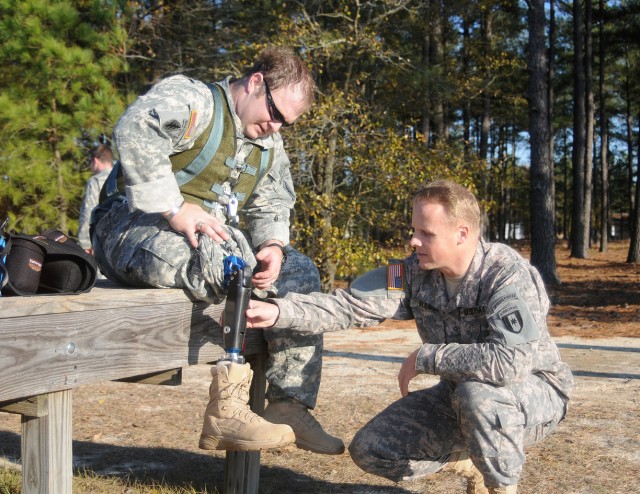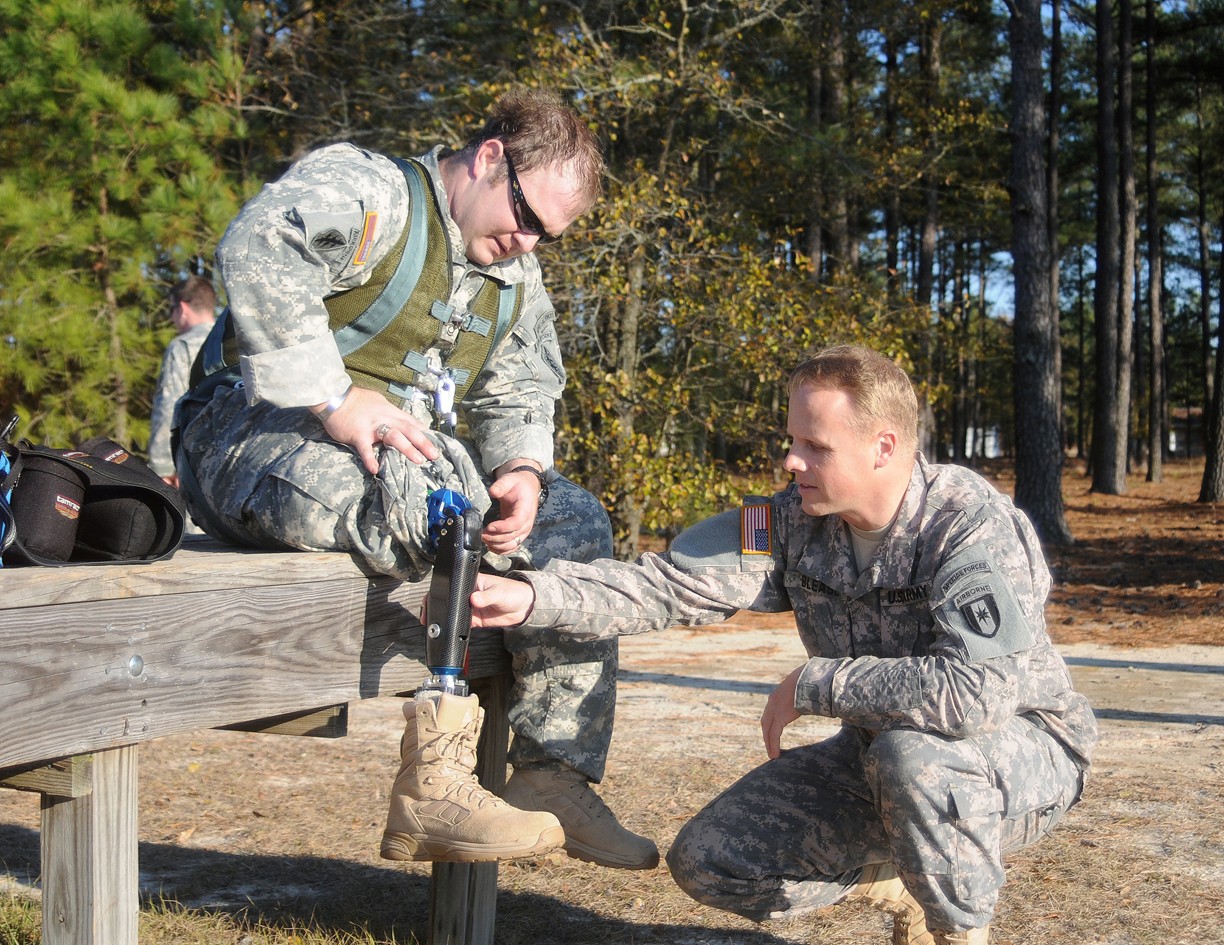WHEN individuals join the Army, they set their sights on a host of advanced schools, like Air Assault, Ranger and Pathfinder. An airborne-qualified noncommissioned officer also sets his sights on the Jumpmaster Course.
Sergeant 1st Class John (Mike) Fairfax faced more than just a minor setback on his path to becoming a jumpmaster. Fairfax, Special Forces Intelligence NCO, Headquarters Support Company, 3rd Special Forces Group, became the first amputee Soldier to successfully complete the Jumpmaster Course, in November 2008.
Fairfax's journey began in a remote region of Afghanistan in the summer of 2005, when an improvised explosive device struck his truck. He suffered a severe injury to his right leg, as well as injuries to his right eye and left lung. His team's medic, Sgt. 1st Class Derrick Coyme, quickly went to work to stop the massive bleeding caused by the severed femoral artery. Just before going unconscious, Fairfax faced the very real possibility that due to his heavy blood loss and the team's remote location, he might not survive the attack.
His next memory was waking to the voice of his wife at his bedside in the Landstuhl Regional Medical Center in Germany. Fairfax knew he was not in the best condition, but felt committed to recovering from his injuries.
"It never crossed my mind that I wouldn't get back to a team," said Fairfax. "My only goal was to get better and continue on with business as usual."
Initially, Fairfax still had his right leg; through several surgeries and battles with infection, doctors were able to save it and he began down the long road of rehabilitation.
December of that same year, Fairfax returned to the group and his leadership gave him one mission: "go get better."
By June 2006 Fairfax was back to work, but spent more than a year struggling with the pain of the injured leg. After several failed surgeries to make the leg more functional and reduce pain, a friend and fellow amputee joked that he should just cut the leg off.
Fairfax gave the option serious consideration.
After consulting several doctors and amputee Soldiers, he decided to go through with the amputation. A year prior to the day of his graduation from the Jumpmaster Course, he had the operation to remove his right leg.
The next year was spent dealing with a cycle of rehabilitation and MRSA (methicillin-resistant Staphylococcus aureus) infections. Each time the MRSA would come back, he was forced to remain off the prosthetic. Once healed, he would have to rebuild the muscle in order to walk.
When he started the Jumpmaster Course, it had only been three weeks since his last bout with MRSA-three weeks since he'd resumed using the prosthetic leg.
"Only being in the socket three weeks really increased the physical demand," said Fairfax. "It takes time to build up the hip flexors and other muscles. I was pretty sore each night during the course."
The majority of the Jumpmaster Course focuses on the jumpmaster personnel inspection.
The sequence requires the Jumpmaster to squat or bend down to visually inspect the jumper's leg straps and positioning of the aviator's kit bag. Most Jumpmasters will go into a deep squat during this portion of the inspection, as going to a knee will take more time when getting up and continuing the inspection. During the final test students are required to properly inspect three jumpers-one wearing full combat equipment-and in five minutes find all deficiencies and conduct the inspection in exact sequence.
Fairfax's only option was to drop to a knee, at times with a violent thud, and then use his good leg to return to a standing position. For fellow students in the course this would be the only clue that he was missing a leg.
"Most guys saw him kind of limping around, but didn't know he was missing a leg," said Master Sgt. David West, 2nd Bn., 3rd SFG and NCOIC during the course. "It wasn't until our first rotation in the (JMPI) circle and he dropped down on the concrete slab. The crack was so loud it sounded like rounds were dropping in. One guy asked him 'did that hurt'' and he responded, "No, I don't have a knee."
Though Fairfax was disadvantaged, there were no changes made to the course's stringent standards. A typical course will see only a 50-percent pass rate.
"Before the start of the course I told myself, failure is not an option," said Fairfax. "I knew I would be paving the way for other amputees to go through the course and I didn't want this to be something they couldn't do." Not only did his success provide fellow amputees with inspiration, but fellow Green Berets as well.
"The majority of the guys and all of the instructors were impressed," said West. "Most were saying to ourselves, 'Holy smokes, would I be able to do that'' To do what he did with a prosthetic leg is a very real inspiration. These are the kind of guys you want in SF, the guys who are going to find a way to get things done. No matter what the circumstances are they will accomplish the task."
West added that Fairfax has always been that type of Soldier. Even before his injury, his motivation was always been inspirational.
"When you wear an SF tab you hold yourself to a higher standard," said Fairfax. "If this can give another guy a glimmer of hope, then that's a good thing. Sometimes you need someone to look up to, someone to look to when you're down."
Fairfax expressed gratitude toward his command for supporting him through his recovery over the past three and a half years and providing him a way to still be a contributing member of the group. "It has always been one of my goals," said Fairfax. "If I can't be on a team, at least I can be a productive Soldier in the group."
Fairfax is focused on more training and accomplishing more goals in the future.
"I don't want this to be the last thing I do," Fairfax said.


Social Sharing